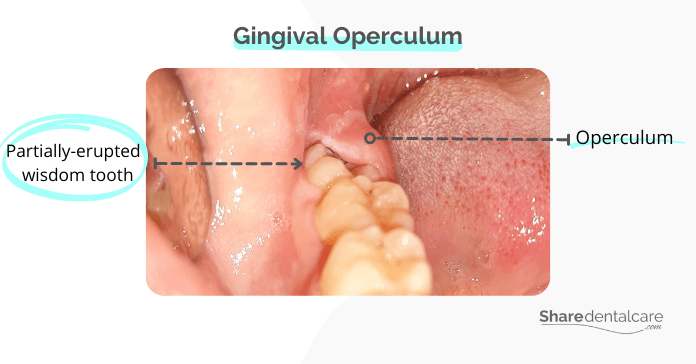The development of a gingival operculum is a common problem many people face when their wisdom teeth begin to emerge. The operculum is a flap of gum tissue that forms over a partially erupted or impacted tooth, causing an increased risk of inflammation and infection. In this blog post, We will discuss the symptoms, home remedies, and treatment options for gingival operculum inflammation.
How Does a Gingival Operculum Develop?
A gingival operculum is caused by a partially erupted or impacted tooth, usually wisdom teeth. When the tooth begins to emerge, the gum tissue can form a flap over it, known as an operculum. This flap can trap food and bacteria, leading to inflammation and infection.
Pericoronitis: Infection of The Gingival Operculum
The gingival operculum is difficult to clean and can easily trap bacteria. When inflammation and infection occur, it is referred to as pericoronitis.
The most common symptom of pericoronitis is inflammation and swelling around the affected area. You may also experience:
- Pain, especially when biting down or chewing food
- Redness and tenderness
- Bad breath
- Formation of an abscess (a collection of pus) on the gums
- Difficulty opening your mouth wide.
- Swollen lymph nodes in the neck
In more severe cases, you may develop a fever or headache. If you experience any of these symptoms, it’s important to seek treatment right away. Without treatment, the condition can lead to more serious issues.

Pericoronitis Risk Factors
Certain factors can increase your risk of developing pericoronitis, including:
- Having a partially erupted or impacted wisdom tooth
- Poor oral hygiene: Not brushing and flossing regularly
- Poor nutrition: Not eating a balanced diet with enough vitamins and minerals
- Smoking or chewing tobacco products
If you’re at risk for pericoronitis, make sure to practice good oral hygiene habits and visit your dentist regularly to ensure that any underlying issues are identified and treated promptly.
Home Remedies for Gingival Operculum Infection
Some home remedies can help relieve pain and swelling associated with gingival operculum infection.
- Over-the-counter medications: Taking over-the-counter pain relievers such as ibuprofen and acetaminophen can help manage discomfort associated with gingival operculum infection.
- Rinsing with a saltwater solution: Mix 1 teaspoon of salt in 1 cup of warm water and use it to rinse your mouth several times a day. This can help reduce inflammation and relieve pericoronitis pain.
- Use an antimicrobial mouthwash: Antimicrobial mouthwashes contain ingredients such as chlorhexidine, which can help reduce the number of bacteria in your mouth. This can help reduce inflammation and pain.
- Avoid certain foods: Eating spicy, acidic, and crunchy foods may irritate the affected area and make symptoms worse.
- Practice good oral hygiene: Brush your teeth with a soft toothbrush to remove trapped food particles and gently floss between your teeth.
Pericoronitis home remedies can help relieve the pain and discomfort of inflamed gums. However, they don’t address the underlying cause of the inflammation. Therefore, you should see your dentist for diagnosis and treatment.
Treatment Options
Your dentist may recommend one or more of the following for treating inflamed gingival operculum:
- Professional teeth cleanings: Your dentist may suggest having your teeth professionally cleaned to remove any food debris, plaque buildup, and tartar from around the affected area.
- Antibiotics: Your dentist may prescribe antibiotics to help fight infection. They may be taken orally or applied directly to the affected area.
- Surgical treatments: In some cases, your dentist may recommend a surgical procedure, known as an operculectomy, to remove the operculum that has become inflamed.
- Extraction of the wisdom tooth: Your dentist may recommend removing the wisdom tooth to prevent the recurrence of pericoronitis.
Gingival Operculum – Conclusion
The gingival operculum is a flap of gum tissue that develops around the crown of a partially erupted or impacted tooth. This gum flap can trap food particles and bacteria, leading to inflammation and infection known as pericoronitis. While it is not a serious condition, it can be painful and uncomfortable.
Home remedies, such as OTC pain medications and warm salt water rinses, can help provide relief. However, they don’t address the underlying cause of the condition.
Therefore, you should see a dentist for diagnosis and treatment. The dentist may recommend removing the gingival operculum (operculectomy) or extracting the wisdom tooth to prevent the recurrence of pericoronitis.